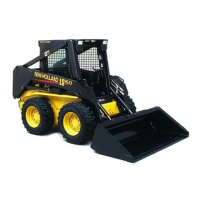SECTION 29 - HYDROSTATIC TRANSMISSION
29-3
Op. 29 100
GENERAL INFORMATION
The hydrostatic system provides a means to transfer
power from the engine to the final drive for the
wheels. It provides infinitely variable speed forward
and reverse and steering of the skid steer.
The hydrostatic pumps receive power from the
engine through a flex plate drive. The pumps transfer
hydraulic power to the motors and then through
gearboxes to the final drives, axles, and wheels.
The hydrostatic pumps are controlled separately
from each other and power each side independently.
OPERATION
The hydrostatic system is a closed loop fluid power
system that provides smooth transition of power from
the engine to the wheels. The hydrostatic system is
made up of two piston pumps, 1, and two piston
motors, 2. The hydrostatic charge system is a back
pressure valve in the hydraulic system return line
located in the engine compartment. This provides
replenishing oil for the oil that is lost due to leakage
for lubrication and cooling purposes.
Steering is controlled by two hand levers, 3, located
in the operators cab. These hand levers control
direction forward and reverse and amount of oil flow
for speed of the skid steer by rotation of the pump
cam plates in the individual pumps. The further the
control levers are pushed from neutral the greater the
cam plate angle. More oil is pumped to the motors
increasing the wheel speed. The greatest wheel
torque is when the control levers are closer to
neutral. When operating the skid steer, more power
(torque) is available by destroking the control levers,
thus increasing the loader efficiency.
19992568
3
3
2
2
1
1

